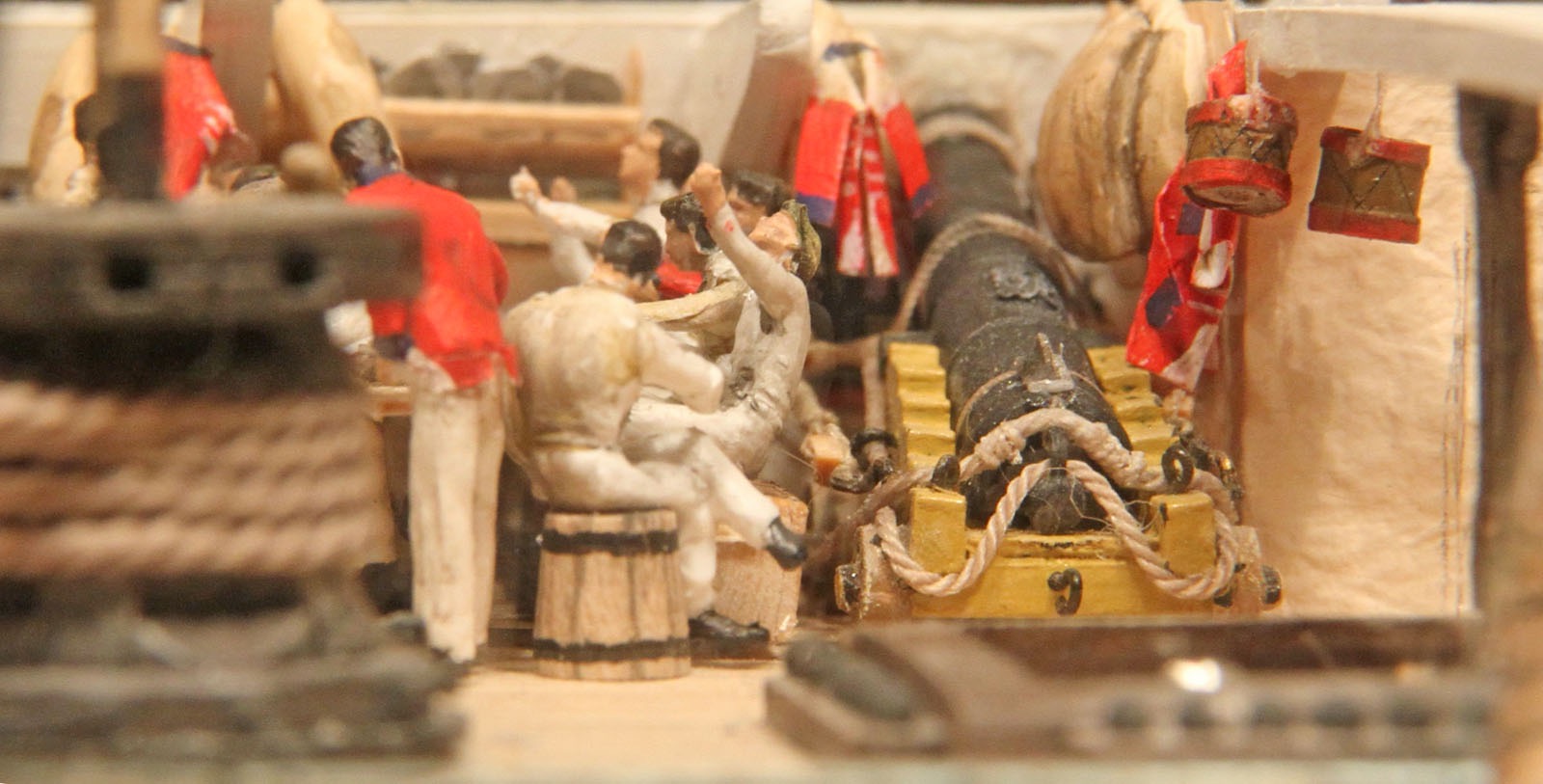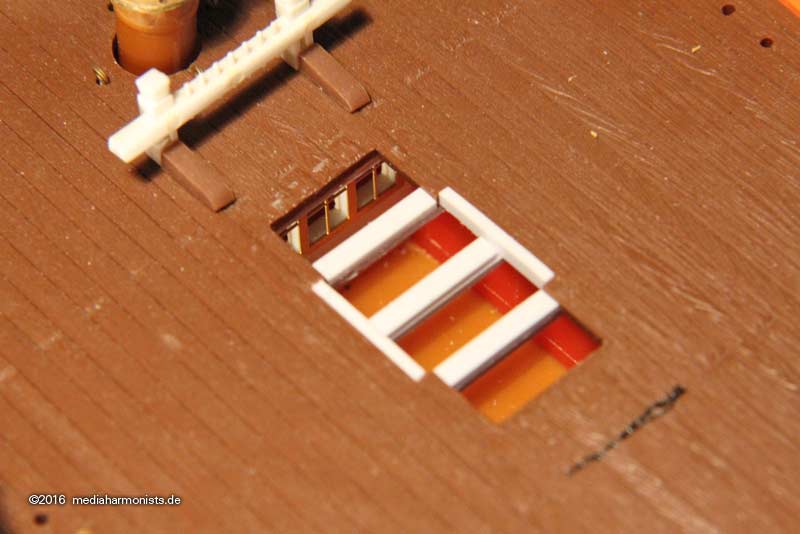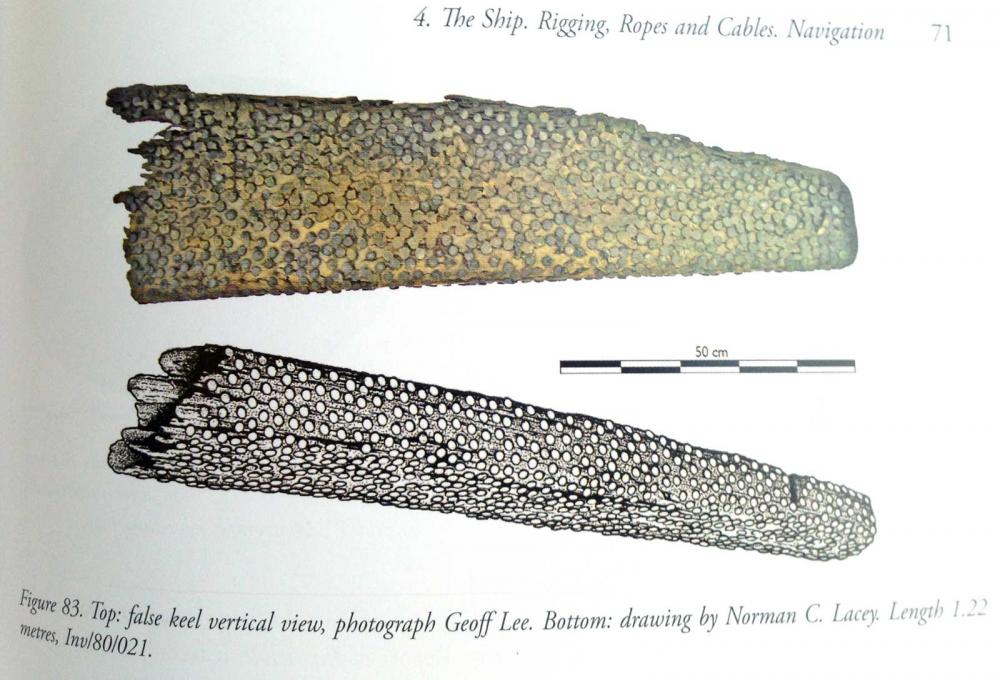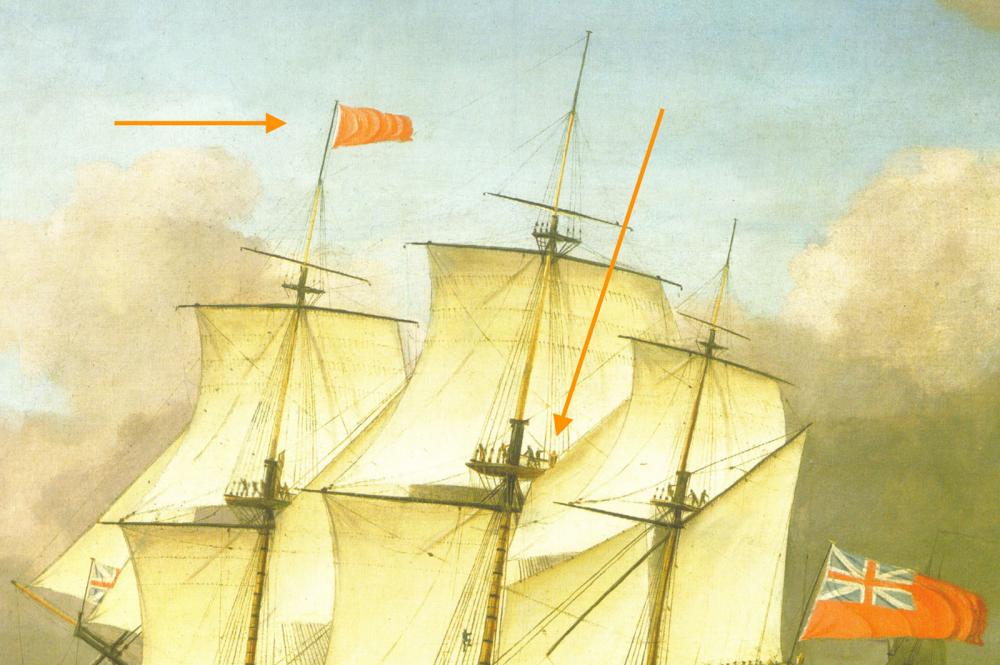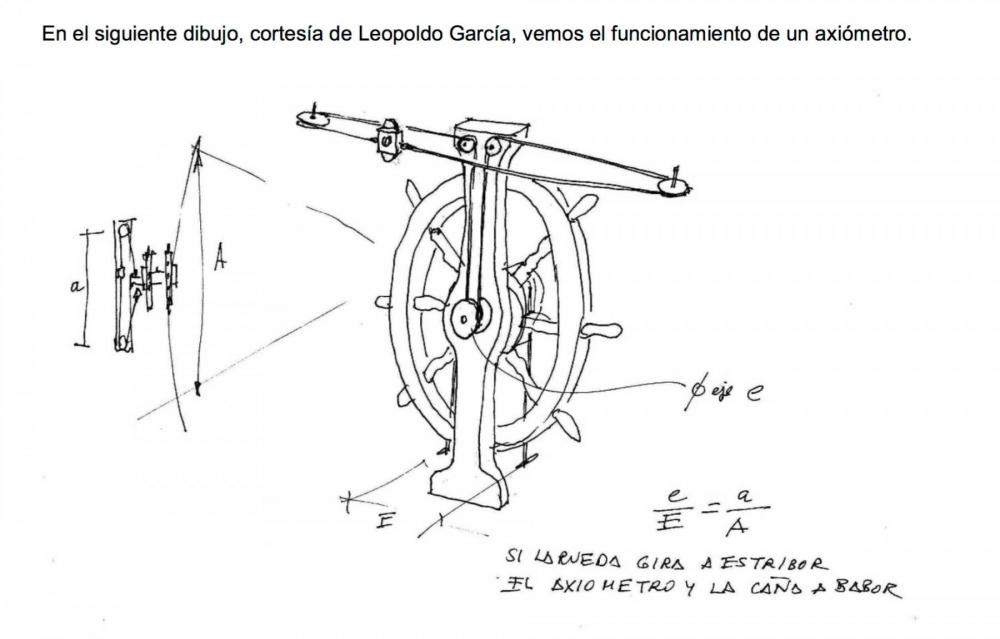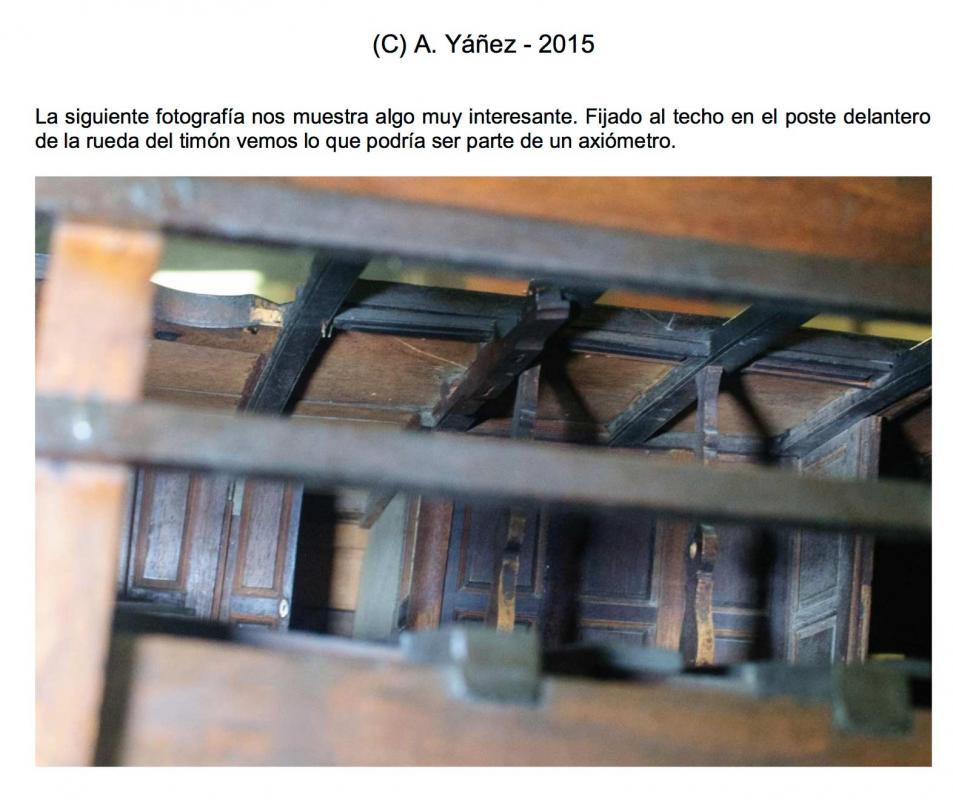-
Posts
2,426 -
Joined
-
Last visited
Content Type
Profiles
Forums
Gallery
Events
Everything posted by dafi
-
I think one gets easily tricked by the fact an iron anchor as a very heavy object. Just some thoughts to jud´s interesting question: The cat hook is to be hooked in as soon as the ring breaks the surface. This can be seen nicely on the famous picture of the Royal Sovereign with the little man standing on the anchor´s stock handling the cat block´s hook. At this moment the weight of the anchor is far less as it is not its weight of iron but only the one of the displayed water, which is - if I am right - 1/7th of the weight of iron. Afterwards the cathead, cat tackle and all the other rigging parts of the fishing rigging have to take the whole weight of the iron. As the ship is always drifting with wind and current, the anchor cable always will have a certain direction a forehead. The ship should neighter run over the anchor, so a turn backwards of the cable was less favoured. Also breaking the anchor was often done by the big boats means there should usually not be the pull spill-hawse-downwards. So the pull downwards is far less than expected imho, but I do strongly believe, that a ship an a long cable, especially in a strong gale, will pull with a multitude of the anchor ´s weight. So it makes for me perfect sense to have the hawsers horizontal for that case, means in the direction of the ship pulling on the cable and having the minimum of breakage risk or chafing in those moments :-) XXXDAn
-
I knew it! I KNEW it! I knew I took pictures while taming the lions :-) Here is the addendum´s addendum. Yes that thing in the right lower corner is my scalpel. Some more before-after shots. XXXDAn
-
Bern in Switzerland at night and it rains cats and dogs. Lovely city with wonderful arcades and beautiful shops, but all closed by this time. To wet to do anything else so I sit underneath the arcades in front of the hotel and do some more addenda - bad luck for you lot ;-) If being fed up with gross motor skilled work like the planking or skylighting, I still had something else to do. As I already knew that I will need two more figure heads, so i decided to do a decent one, and this time to hopefully do a casting of it. Here are two Heller originals. and even here one is less crisp than the other and even that one has the appearance of an old chewed and sucked out chewing gum … … that is why I spend several nighttimes giving some TLC wich the help of my scraping skills and a scalpel … … and no, the red is no blood, it is only Edding marker to have a control what i was doing. And suddenly the horse started to jump, the harp harped again, the ice bucket rebecame Charlemagne’s crown and the duke´s hat behated everything once more and the undercuts finally cutted under … … only .. … only the lions where not be be revived by this treatment, so I replaced them by thin sheet like I already did with figure-head.1 :-) And to crown the assembly … … massacred the old crown … … to serve as a bending template for the replacement. Hollowed the base … … and checked how much space was under the spriet mast. Shortened the top accordingly … … and it looked good :-) O yes the small lettering was also fixed. After using pincers and paint, after spray glue and CA I tried something new, transparent Post-its Cut in small stripes … … and catch the letter with the sticky side - the transparent allows to see the orientation - applied little CA … … placed it and used something pointed to press against the surface … … and it fits :-) XXXDAn
-
Oh those marvels of modern technology. Sitting in the car towards a job in Switzerland and being able to update some of the late progress***. Not much was possible, just small bits late night, so one had to find the right subject - I found one, not too far off :-) I love the small etch skylight, but as all etch it misses a bit of depth. Long time I wanted to try something. First glued some 0,25 mm sheet onto the back of the roof using CA … … cleaned the edges, drilled the holes and opened the windows with a file using the brass as template … … and then separated the parts very caaaaaaaaarefully using a scalpel. Then cleaned the back of the roof and glued the clear sheet onto it by just applying CA on the edges to minimise fumes and mess … … and glued the sheet back in place thus resulting into a nice three level sandwich brass-clear sheet-normal sheet with a nice edge with the right thickness :-) The sides went alike, first clear, then normal, this time using Evergreen for the glazing bars fixed with UHU-Plast. Like this, the „glass“ is nicely packed in the middle. The lower part was left longer on purpose as this gives a nice anchorage on the deck. Still added the deck beams … … and it already looked rather cute … … even reflecting in the light. Even though I used clear sheet, how was the original glazed? Using mica for the advantage of not breaking? Or old fashioned very disturbed glas? Cheers, Daniel PS: ***Do not worry, my colleague is driving ;-)
-
... just like the left- and right hand layed shrouds Mondfeld published in his (in)famous book. That was THE TRUTH for many-many modelers for decades, until proven wrong (and later admitted by M.). On the other hand there are sometimes multiple truths. Not just only one version - so a proven fact is only one possibility. See the section in Steel about the made masts and see the so believed original artefact of Victorys fore mast with a much simplified assembly. Cheers, DAniel
-
Thank you B.E. :-) :-) :-) I took the liberty to add them to the spoiler list, always owing you credits to your always sharp eagle eye and cerebral database! Rare to be matched! XXXDAn
-
The best source is the mentioned Victory-forum at http://pete-coleman.com/forum/, especially for the Heller kit :-) The kit represents the ship quite faithfully as it was believed in the 1960ies to have looked like at this special October, 21st 1805, but since then "latest resaearch" revealed a lot of changes, not only for the color and still things are changing ... And always to point out: The Heller kit in itself is a wonderful start and was really state of the art in the 1970ies research and production wise, but simply is outdated a bit. Most important: The form of the hull in itself, the stern and side galleries are imho the most true full of all the kits available - plastic and wood !!! Not to give frustration upon all the brave Vic-modellers up to date, I strongly suggest only the bravest of the brave to have a look in there, and if so, to have all their sedatives, tranquilizers, calmative and defibrillators in reach, (ok, just kiddin´!) Cheers, Daniel
-
And anyway, the new position makes much sense, as it is much more centered over the room. The original Heller cut-out that is shown shown in this picture here on my unpainted model is is with its front edge exactly over the bulkhead of the cabin, leaving the back of the room dark. The black line is the optimised version shown in the previous posts and coincides with the (btw all wrong) splitline of the deck planking. XXXDAn
-
Dear MAurice, with all the good preparations you lot did at www.pete-coleman.com one can´t go wrong :-) XXXDan
-
They are parallel :-) I was not sure how to place them, but it looked strange in the area of the skylight having them curved there. Also with the two middle partners in the back. XXXDAn
-
What a sad story ... ... after the big modelers meeting in Augsburg near Munich in March my sweet black´n´yellow beaty even did not make it back up to the tinkering table and had to stay in the staircase ... ... the poor one, all alone ... ... ... :-( Until today she went underneath the knife again - HUUUUURRRRRAYYYY! First relocating the skylight of the poop. Being a little to much upfront ... ... bravely using the knife ... ... and resettling the cut out. And then something I always wanted to try out ... ... the new planking in between the binding strakes still parallel because of the 2 middle poop deck partners ... ... but then getting curved towards the outer hull. After gluing the planks cutting with a plexi ruler in several turns into shape ... ... and so I got a nice deck with curved planks and that even in 1:100, so no more excuses for the bigger scales ;-) XXXDAn
-
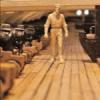
Caroline's bottom
dafi replied to GrantGoodale's topic in Building, Framing, Planking and plating a ships hull and deck
I just got the book First HMS Invincible (1747-1758) from John Bingeman There I found a picture of the false keel, with plenty of nails, could this be the "pease"? XXXDAn -
One more question. As the gangway was originally a special feature and was positioned a bit underneath the forecastle and the quarter deck it had a own planking sceme. How was the split of fo´castle and gangway and gangway and quarterdeck handled in regards of the planking handled later on when the gangway moved onto the same level as those decks? Was there first still a split/break in the planking pattern or when did it start to be planked over as it was a single deck? In especially I am of course interested into the handling around 1803 when the vic was recommissioned still havin a very narrow gangway? Cheers, DAniel PS: Please do not refer to the 1:1 model in P. ;-) (There is a small spilt)
-
The best guessing until now in my personal opinion was for sauve-tête netting or sunsails or other "convenience"-items as there is no documentation for rigging to be attached there. But by the position of the rollers (if they are!) there is no pull pointing upwards of the line or it would have jumped out of the lead, so one could guess that these are for handling cables from the mizzen and others bits down to the quarterdeck to have more space for the men to work on the lines ?!? Cheers, DAniel
-
Robin and Wayne, wonderful team you are :-) In Bruzelius found the passage that Robin cited: http://www.bruzelius.info/Nautica/Signalling/SFI(1775)-2.html Sailing and Fighting Instructions for His Majesty's Fleet. Signals by Day. Distinguishing Lights for the Flags. INSTR. I. The Admiral, who commands the Fleet, is to have three Lights on the Poop, and one on the Main-top. II. The Vice-Admiral, or he who has the Second Post, to have two on his Poop, and one on his Main-top. III. The Rear-Admiral, or he who has the Third Post, one on his Main-top, and one on his Poop. IV. The Vice-Admiral of each Squadron, two on his Poop. V. The Rear-Admiral of each Squadron, one on his Poop: But when the whole Fleet carry their Lights, then the rear-Admiral of each Squadron is to carry two Lights, the one hoisted a Yard above the other, on the Ensign-staff. VI. In Case of foul Weather, and a dark Night, each Ship is to carry a Light. Sailing and Fighting Instructions for His Majesty's Fleet, 1775. Still have to look for the citation in the larger script. Thanks a lot mates, you are wonderful! XXXDAn *rushing off to take his lantern from the fore top to the main* PS: Hope nothing changed compared to 1805 ;-) Any idea if Lavery had a bad information or if his quote was appicable in another time frame?
-
Quite a while ago Blue Ensign pointed me to an interesting question. Todays Victory is carrying a lantern in the main top. Lavery points out in Arming and Fitting on page 255 that the position of the lantern follows the rank: Admiral in the main top, Vice Admiral in the fore top and Rear Admiral in the mizzen top. As Nelson was Vice Admiral of the White at Trafalgar, the lantern should be displayed in the fore top to show the correct position at Trafalgar as indicated by Lavery. But apart from Laverys remark I did not found any other mention of this practice, the only reference he gives is the Public Record office Adm 106/2233, 26 Jan 1804, unfortunately unknown to me. Does anybody have access to it? But I just stumbled across another contradicting reference, again, it did not jump into my eye even though I examined the picture laready multiple times. Painting "The 'Victory' Leaving the Channel in 1793" Monamie Swaine, http://collections.rmg.co.uk/collections/objects/15169.html BHC3696 The 'Victory' is shown broadside to port, going down Channel to windward with Rudyerd's Eddystone Lighthouse distantly visible beyond her stern. She is shown flying the flag of Lord Hood as Vice-Admiral of the Red (red at the fore), as she heads outward-bound with her squadron in 1793 for the Mediterranean, where she was Hood's flagship at the Siege of Toulon and the invasion of Corsica. Hood had been promoted to Admiral of the Blue by the time he returned in November 1794, and on the left 'Victory' is shown again, leading the return of his squadron. In the main view 'Victory' also flies a Union jack on her bowsprit and a red ensign, as do other ships of the outward-bound squadron following her. The 'Victory' was floated out of dock at Chatham in 1765 and the picture shows her as built except that she has been coppered. This process first took place in March 1780, when the bottom of the ship below the waterline was sheathed with 3923 sheets of copper to protect her hull against ship-worm. The name 'Victory' is present on the stern. In 1797she was Sir John Jervis's flagship at the Battle of Cape St Vincent and in 1801-03 had a major rebuild at Chatham that enclosed her stern galleries and gave her a new figurehead. She then went to the Mediterranean as Nelson's flagship, up to and including at the Battle of Trafalgar in 1805. Monamy was the son of the better-known Francis Swaine and grandson of the even more famous Peter Monamy, after whom he was named. He was active from about 1769 to 1774 and, if this painting is by him, into the 1790s. As an artist he specialized in still-life and genre, although he exhibited two marine pictures at the Free Society of Artists in 1771 and 1772. Date made circa 1795 Even though Hood was Vice Admiral - correctly displayed with the flag on the fore mast - the lantern is on the main top: That leads me to the question: Does anybody have more information about the regulations of putting the mast top lanterns? Cheers and thanks, Daniel
-
Wunderherrlich! Marveilleux! XXXDAn
- 2,625 replies
-
- kaiser wilhelm der grosse
- passenger steamer
-
(and 1 more)
Tagged with:
-
And todays Spanish lesson :-) Thanks to Peregrino for the great work on the documentation of San Juan Nepomuceno http://modelshipworld.com/index.php/topic/13117-spanish-74-gautier-system/#entry407942 See the original here: https://dl.dropboxusercontent.com/u/47335803/Nepomuceno_foro.pdf Interessting is the formula e/E=a/A to get the small drum´s diameter. And see the display bolted underneath the deck beam, having the deflection roller incorporated. XXXDAn
-
And todays Spanish lesson :-) Thanks to Peregrino for the great work on the documentation of San Juan Nepomuceno http://modelshipworld.com/index.php/topic/13117-spanish-74-gautier-system/#entry407942 See the original here: https://dl.dropboxusercontent.com/u/47335803/Nepomuceno_foro.pdf Interessting is the formula e/E=a/A to get the small drum´s diameter. And see the display bolted underneath the deck beam, having the deflection roller incorporated. XXXDAn
About us
Modelshipworld - Advancing Ship Modeling through Research
SSL Secured
Your security is important for us so this Website is SSL-Secured
NRG Mailing Address
Nautical Research Guild
237 South Lincoln Street
Westmont IL, 60559-1917
Model Ship World ® and the MSW logo are Registered Trademarks, and belong to the Nautical Research Guild (United States Patent and Trademark Office: No. 6,929,264 & No. 6,929,274, registered Dec. 20, 2022)
Helpful Links
About the NRG
If you enjoy building ship models that are historically accurate as well as beautiful, then The Nautical Research Guild (NRG) is just right for you.
The Guild is a non-profit educational organization whose mission is to “Advance Ship Modeling Through Research”. We provide support to our members in their efforts to raise the quality of their model ships.
The Nautical Research Guild has published our world-renowned quarterly magazine, The Nautical Research Journal, since 1955. The pages of the Journal are full of articles by accomplished ship modelers who show you how they create those exquisite details on their models, and by maritime historians who show you the correct details to build. The Journal is available in both print and digital editions. Go to the NRG web site (www.thenrg.org) to download a complimentary digital copy of the Journal. The NRG also publishes plan sets, books and compilations of back issues of the Journal and the former Ships in Scale and Model Ship Builder magazines.

